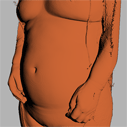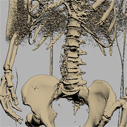 In this paper [pdf] we propose a novel point-based approach to view
dependent isosurface extraction. We also introduce a fast
visibility query system for the view dependent traversal, which
exhibits moderate memory requirements. Using this approach we
achieved an interactive interrogation of the full visible woman
dataset (1GB) at more then 4 frames per seconds on a desktop
computer.
In this paper [pdf] we propose a novel point-based approach to view
dependent isosurface extraction. We also introduce a fast
visibility query system for the view dependent traversal, which
exhibits moderate memory requirements. Using this approach we
achieved an interactive interrogation of the full visible woman
dataset (1GB) at more then 4 frames per seconds on a desktop
computer.
 The point based approach is based on an extraction scheme that
classify different sections of the isosurface into four
different categories. The classification is based on the size
of the geometry when projected onto the screen. In particular,
we use points to represent small and sub-pixel triangles as
well as large sections of the isosurface which project to less
then a pixel on the screen.
The point based approach is based on an extraction scheme that
classify different sections of the isosurface into four
different categories. The classification is based on the size
of the geometry when projected onto the screen. In particular,
we use points to represent small and sub-pixel triangles as
well as large sections of the isosurface which project to less
then a pixel on the screen.
 An important issue in point based representation is how to
define a normal to a point that represent a large, but far,
sections of the isosurface. We propose to define such normals
based on post processing of the extracted isosurface and show a
hardware implementation using a vertex and fragment
programs. The ability to define the normals using screen space
connectivity opens the door to further image space effects such
as boundary enhancements that are especially vital for complex
isosurfaces.
An important issue in point based representation is how to
define a normal to a point that represent a large, but far,
sections of the isosurface. We propose to define such normals
based on post processing of the extracted isosurface and show a
hardware implementation using a vertex and fragment
programs. The ability to define the normals using screen space
connectivity opens the door to further image space effects such
as boundary enhancements that are especially vital for complex
isosurfaces.


